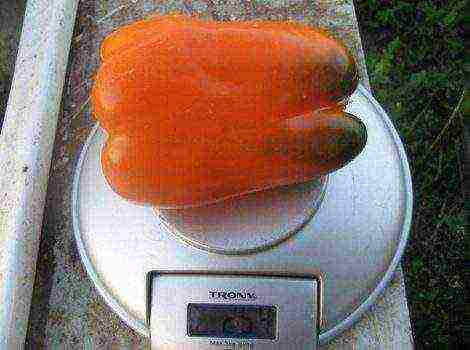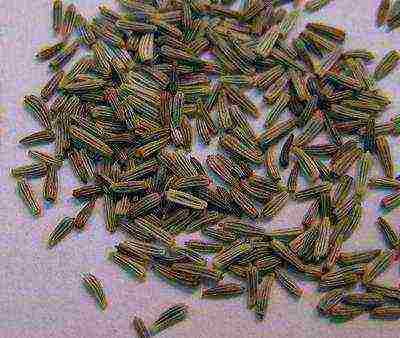Content
- 1 Rules for choosing a seed for planting
- 2 Sevka bulb size
- 3 Varieties for planting in the middle lane
- 4 Spicy, semi-sharp, sweet onions - looking for differences
- 5 Popular varieties of red, yellow and white onions
- 6 Stuttgarter Riesen
- 7 Sturon
- 8 Centurion
- 9 Red Baron
- 10 Carmen
- 11 Stardust
- 12 Shetana
- 13 Shallot
- 14 Bamberger
- 15 Hercules
- 16 Corrado
- 17 Cupid
- 18 Rumba
- 19 Alpha
- 20 Shakespeare
- 21 Senshui
- 22 Rosanna
- 23 Alvina
- 24 Golden domes
- 25 Odintsovets
- 26 Video "Planting onion sets"
- 27 How to choose a good set
- 28 The best varieties
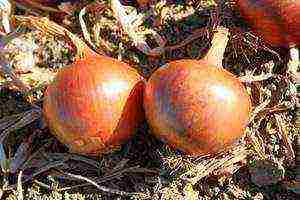 With the arrival of spring, the summer season begins. Gardeners are faced with many issues that need to be resolved in a short time. The most basic of these is the question of which crops to plant this year first.
With the arrival of spring, the summer season begins. Gardeners are faced with many issues that need to be resolved in a short time. The most basic of these is the question of which crops to plant this year first.
Gardeners grow different types of vegetables and fruits, and often onions are among them. It is unpretentious, does not require special and complex care, but is very often used in the preparation of various dishes.
The choice of such a crop for planting is quite justified, but it often causes difficulties, since inexperienced summer residents experience some difficulties in the selection of planting material among a wide variety of varieties. To make the right choice, you should know what characteristics and tastes this or that type of onion possesses.
Rules for choosing a seed for planting
Before proceeding with planting sevka, you should decide on what what qualities the final product should have.
Usually summer residents prefer to simply buy planting material at the nearest gardener store. But you can do more difficult - prepare the set yourself and save on buying it.
It doesn't matter which of these two methods you choose, but you should definitely know all the criteria that you need to focus on when selecting seedlings. When choosing a set the following main parameters are distinguished:
Same
- Taste qualities. This parameter is worth paying attention to first of all, since onions are grown for human consumption.
- Resistance of the variety to environmental conditions, for example, high humidity or frost. If the sevok is dependent on such indicators, then its growth will not be active. Therefore, when choosing a planting material, do not forget that it is often not recommended to touch the seed during storage before planting, since such actions can accelerate its germination.
- The seedlings should smell like regular onions and be free from rot, dampness and mold.
- Form. The shape of the onion depends on the characteristics of the particular variety or variety. Summer residents rarely pay attention to this, since most are interested in the taste of the vegetable, and not what shape the grown bulb will have - round or elongated.
- A batch of good quality commercial seedlings may contain several dried bulbs, but these rarely exceed one percent of the total.
- High-quality onion sets are always covered with dry husks. Its presence indicates that the planting material has dried well.
- The bulbs should not show any traces of mechanical damage.
- A well-dried set is considered the most suitable for planting, but wet bulbs are allowed in the batch. They will need to be separated from dry and dried.
- Each bulb, with its color and size, must prove that it belongs to the selected variety.
- Good planting stock should be uniform in color and free from obscure spots.
- When buying onion sets, ask the seller to provide you with the exact name of the variety, the shelf life of the crop and its main characteristics. Such information is very important, because different varieties differ from each other, have different characteristics that affect the germination of planting material and yield. If the set is sold in a package, then look for this information on it.
- Appearance. The main sign of a high-quality seed is a dense structure and an even surface of the bulb. The husk should not show signs of disease and rot, as well as traces of pests.
Sevka bulb size
Among the other parameters that should be taken into account when choosing a planting material, the size of the bulbs should be highlighted. Based on this criterion, representatives of crop production have identified three main groups of sets, differing from each other in size:
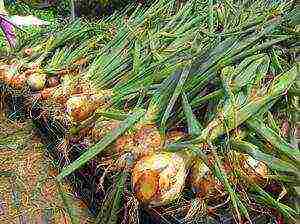 Small breeding. Sevok, which is a representative of this group, has a small size, only 10-15 mm. Such varieties are chosen for planting before winter.
Small breeding. Sevok, which is a representative of this group, has a small size, only 10-15 mm. Such varieties are chosen for planting before winter.- Middle-nesting. This group includes varieties, the size of the bulbs of which is 15-22 mm.
- Multi-slotted. This group includes plants with a bulb size of 22-40 mm.
Varieties belonging to the representatives of the second and third groups are stored in winter until the beginning of spring, since they are intended for planting at this particular time of the year. Large varieties of onion sets are great for producing green feathers in winter and spring.
Varieties for planting in the middle lane
To get a good harvest of onions, it is worth taking up not only the selection of high-quality sets for planting, but also choosing the right variety for your climatic conditions... All forms have their own characteristics, for example, cost, ripening period and yield. Today the market offers a huge amount of planting material of a wide variety of varieties. Among all this assortment, the most popular spring species should be highlighted, which are preferred by Russian gardeners.
Sturon
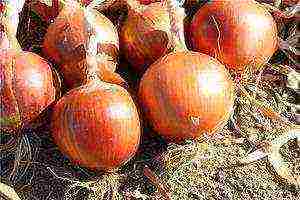 Due to its quality characteristics, Sturon is one of the highly recommended onion varieties among gardeners and summer residents. The main advantage of this form is early ripening... In addition, it is renowned for its good taste, juiciness and moderate pungency.
Due to its quality characteristics, Sturon is one of the highly recommended onion varieties among gardeners and summer residents. The main advantage of this form is early ripening... In addition, it is renowned for its good taste, juiciness and moderate pungency.
Technically mature bulbs can be medium to large in size. When it comes time to harvest, one Sturon bulb weighs between 90 and 150 g. During the ripening process, the fruits of this variety form one nest.
Of the other virtues of Sturon it is worth noting the high percentage of germination and good yield. The disadvantages include the inability to obtain green feathers. Since the variety is considered early ripe, they begin to harvest it 8-12 days before the dates usual for onions.
Ideal for growing in northern climates such as Russia, Northern Europe and Scandinavia. It is resistant to various diseases. Many summer residents and farmers choose this particular variety for planting and subsequent sale, since it has a long shelf life.
Stuttgarter Riesen
Stuttgarter Riesen is another popular early ripening variety. It is often chosen for cultivation in Russia, as it is well adapted to our climatic conditions. The bulbs are dense in structure, can vary in shape and weight, be flat or round, medium or large in size. A pronounced pungency is felt on the taste. Medium bulbs weigh from 50 to 94 g, and large ones - from 150 to 300 g. It stands out among other varieties with a high content of vitamin C.
Reproduction can take place in three ways:
- Sevkom.
- Seeds.
- Seedlings.
Stuttgarter Riesen is characterized as a very productive variety with high germination and long shelf life.To get a good harvest, such onions should be watered regularly, and the soil should be loosened and weeds removed. Able to maintain its commercial qualities for about six months.
The disadvantages of this variety include the inability to resist diseases. Neck rot and downy mildew can lead to the death of planting material and plants.
Centurion
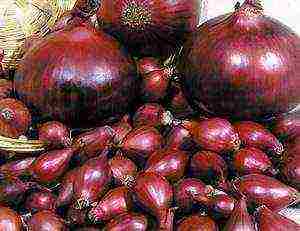 Centurion is newbred by breeders in the framework of the Stuttgarter Riesen variety. The bulb has a standard elongated shape, has a weight of about 110-150 g. The taste is quite spicy, suitable for long-term storage, does not lose its shape and taste.
Centurion is newbred by breeders in the framework of the Stuttgarter Riesen variety. The bulb has a standard elongated shape, has a weight of about 110-150 g. The taste is quite spicy, suitable for long-term storage, does not lose its shape and taste.
Able to show one hundred percent germination if planting took place under favorable conditions. It can give a good harvest if you follow all the rules of care. It successfully resists almost all known diseases.
Not used for growing greens, is an excellent planting material for sevka. It very rarely grows into an arrow, it is distinguished by keeping quality. It is used for cultivation with the aim of the subsequent sale of goods.
Hercules
Hercules - medium early variety, bulbs are round, large in size. Perfect for growing in all regions of Russia. Upon reaching technical maturity, the fruits have an elliptical shape and a weight of about 160 g.
Hercules has a pleasant taste - it is quite sweet, but spicy is felt. The advantages of the variety include high keeping quality and productivity, long shelf life and good disease resistance. Does not lend itself to fusarium, pink and bottom rot.
Red Baron
Red Baron - a representative of early varieties, differs from other varieties in its red or purple color. At harvest, it reaches a rounded shape, can be small or large and weigh from 25 to 40 g or from 130 to 150 g.
Farmers and summer residents choose this variety because of its stable yield, good ripening and excellent keeping quality. It pleases with its taste with a slight pungency. Needs regular watering, weeding and loosen the soil should also be carried out. In this case, you can get a good and high-quality harvest. It is able to reproduce in several ways, namely: by sevkom, seedlings or with the help of seeds.
The sweet and pleasant taste of this onion variety has contributed to the fact that it is often consumed fresh and used in salads.
Carmen
 Carmen refers to varieties with red bulbs. It tastes good with little pungency. The bulbs are of medium density and rounded, slightly flattened. They can weigh between 50 and 120 g.
Carmen refers to varieties with red bulbs. It tastes good with little pungency. The bulbs are of medium density and rounded, slightly flattened. They can weigh between 50 and 120 g.
Carmen is high in vitamin C and dry matter. It is well stored and brings a large harvest, you can feast on them almost all winter. Propagated not only by seedlings, but also by seedlings or seeds.
Stardust
Stardust - medium early variety, it can be used for spring sowing. He has a very pleasant taste with a slight spice. It is very popular among gardeners due to its high germination rate and yield. The bulbs are even, round in shape, weighing about 30-50 g, but large specimens are often obtained. It is well stored, characterized by high keeping quality. Propagated by sowing or using seeds.
Orion
Orion Is an English early ripening hybrid variety. Its bulbs are perfectly round and grow to a large size. The weight of one copy reaches 150-200 g.
Orion is quite in demand among gardeners, as it has a good keeping quality.
Shtur BS-20
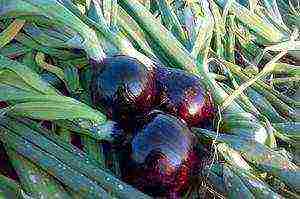 Shtur BS-20 is a representative of medium late ripening varieties. The husk is colored yellow, the pulp is white and juicy. Rich in a number of dry substances. The bulbs are round and smooth. Stores well and retains its taste during the entire shelf life.
Shtur BS-20 is a representative of medium late ripening varieties. The husk is colored yellow, the pulp is white and juicy. Rich in a number of dry substances. The bulbs are round and smooth. Stores well and retains its taste during the entire shelf life.
Every summer resident hopes to get a good harvest of sweet onions when planting sets. With the right choice of sevka and varieties, even in the absence of experience, you can achieve excellent results in central Russia and its northern regions.
When choosing planting material, you should rely on qualitative characteristics of the set, since you can get a harvest of a marketable type only using the bulbs that have been stored correctly.
Of course, a lot depends on the type of onion itself. The market is replete with variety and a large assortment, so you should make a choice, taking into account your wishes for the future harvest. You will need to decide what is more important: size, ripening period or shelf life.
Attention, only TODAY!
Do you want to grow onions but don't know which variety to choose? Then be sure to read our article.
We will introduce you to the best varieties of onions that you can grow on your site without any problems.
When choosing a variety of onions for a summer residence, pay attention to its regionality. Depending on the area of growth, onion varieties can be divided into 2 types:
- southern;
- northern.
Southern varieties of onions do not last very long, but they are not very spicy in taste. Some of them are called sweet at all and are referred to as salad types of onions. If you want to get southern varieties of onions in the northern regions or in the middle lane, it is worth growing them through seedlings.
Northern varieties of onions are pungent in taste, but have excellent keeping quality.
White onions are also distinguished. It has a softer and sweeter taste. White onions are among the salad varieties. However, such bulbs are poorly stored, quickly damaged by pests, soften and rot.
In France, it is from white onions that the famous onion soup is prepared.
There are also onion varieties according to the growing season: in the early varieties this period is 90-100 days, in the middle ones - 100-120 days, and in the later ones - more than 120 days.
Depending on the size of the bulb, there are 3 types:
- small - less than 50 g;
- medium - 50-100 g;
- large - more than 100 g.
Depending on how many bulbs can form in the nest, varieties are distinguished:
- small-sized (1-2 bulbs);
- medium-sized (3-4 bulbs);
- multi-nested (5 or more bulbs).
Nesting largely depends on the size of the seedlings, as well as on the growing conditions of the crop. If the planting is larger, and the fertility and moisture content of the soil is higher, then the number of bulbs in the nest will be greater.
Spicy, semi-sharp, sweet onions - looking for differences
All spicy varieties of onions are early ripening. They are distinguished by good keeping quality, high content of essential oils and sugars, but at the same time they are less productive. Such varieties, as a rule, are covered with several layers of outer scales, and therefore they can be removed not only by hand, but also using specialized equipment.
Peninsular onion varieties have few outer scales, and the flesh is not as dense and sharp. Such a bow, when harvesting with special equipment, is often injured and quickly deteriorates. Semi-sharp varieties are considered to be medium-hard and take longer to ripen. However, they give a higher yield than sharp varieties.
Sweet onions taste great and are often used fresh. They give a high yield, but it is stored for a short time. Sharp and semi-sharp onions can be grown in any region. In the southern regions, during the growing season, crops can be obtained even from seeds. And in the middle lane and northern zones - only through seedlings or by planting seedlings. Sweet varieties are grown mostly in hot southern regions from seeds.
Popular varieties of red, yellow and white onions
We bring to your attention well-proven varieties of onions, which are preferred by the absolute majority of gardeners.
Kaba
Late-ripening variety with dense round-flat and rounded bulbs running downwards. The pulp is white, sometimes with a greenish tinge. The outer scales are yellow or light brown. The variety is not resistant to downy mildew (downy mildew), it is also damaged by onion fly.
| Use | Taste | Growing method | Bulb weight (g) | Keeping quality | |
| peninsular |
70-145 |
unsatisfactory | |||
Red baron
Early ripe variety. The bulbs are round, flattened at the top and bottom, red or dark purple on the outside and inside. For larger bulbs, it is recommended to grow this variety through seedlings.
| Use | Taste | Growing method | Bulb weight (g) | Keeping quality | |
| peninsular |
130-150 |
excellent | |||
Snowball
A medium early variety of white onions. It has almost round and white (both outside and inside) bulbs. Quite resistant to shooting, but moderately susceptible to downy mildew and neck rot.
| Use | Taste | Growing method | Bulb weight (g) | Keeping quality | |
| peninsular |
120-200 |
average | |||
Strigunovsky local
An early early ripening variety. It has round, dense bulbs with light pulp and pink or brown outer scales. It can grow in both hot and cool climates without problems.
| Use | Taste | Growing method | Bulb weight (g) | Keeping quality | |
| very spicy |
45-80 |
excellent | |||
Sturon
Mid-season variety. The bulbs are round, white, densely covered with a yellow-brown skin. Resistant to diseases and shooting.
| Use | Taste | Growing method | Bulb weight (g) | Keeping quality | |
|
|
spicy |
70-180 |
excellent | ||
Texas yellow
Early ripe variety. The bulbs are round, rather large, straw-yellow in color with dense white flesh. Resistant to pink root rot.
| Use | Taste | Growing method | Bulb weight (g) | Keeping quality | |
| peninsular |
|
80-150 |
average | ||
Centurion F1
Medium early hybrid with medium-sized, round-elongated bulbs. The pulp is juicy, white, the outer scales are golden brown. The hybrid is resistant to shooting and major onion diseases.
| Use | Taste | Growing method | Bulb weight (g) | Keeping quality | |
| spicy |
65-150 |
excellent | |||
Each of these varieties has stood the test of time and is popular with gardeners. Pay attention to them when you go to the store for sets or onion seeds.
Many farmers are wondering which method of planting onions and which varieties are best to choose? Most of them consider the most effective method of planting by sowing with sets. Onions planted in this way require less maintenance: they do not need to be weeded often, because they grow rather quickly and displace weeds, in addition, its root system is designed in such a way that water for irrigation needs to be spent several times less. Such onions are more resistant to adverse weather conditions, less susceptible to diseases and the negative effects of various pests.
This article will review the most popular varieties of onion sets that a farmer can purchase for planting, and will give a brief description so that when choosing, you know exactly which one is right for you.
Stuttgarter Riesen
One of the most popular onion varieties among amateurs and professionals, bred by German breeders. The harvest of Stuttgarter Riesen is up to 8 kg per square meter, which ensures that it is in great demand in the market. He has large flat-round bulbs, according to the description a little resembling the onions of Strigunovsky onions, weighing 100-150 grams. Stuttgarter tastes quite spicy. The color of this vegetable ranges from yellow-brown to white. Stuttgarter is considered a versatile, well-kept variety that is not difficult to care for.You can buy it, like many other types of onion sets, through the website of the Leroy Merlin company or through the largest Russian-Dutch enterprise for the production of onion sets in Russia - Lukomorye.
Sturon
It is considered an improved version of the Stuttgarter Riesen variety, therefore it is very similar to the latter. It is quite spicy, so it can be used in the preparation of various dishes. Its bulbs are round in shape, and the scales are yellowish or brownish. Gives a relatively large yield, and problems with storage of this variety usually do not arise. For its unpretentiousness and productivity, most professionals choose it for planting.
Centurion
Medium early onion with an elongated medium-sized onion weighing from 100 to 150 grams. The husk that covers the plant is brown, while the middle is white. It has a medium-sharp taste and a high solids content. Because of this, the best way to store the Centurion is to place it in a cool, well-ventilated area. It has a high yield and is widely used in the preparation of various dishes.
Red Baron
Red Baron belongs to the annual onion plants. The red variety to which it belongs always produces a stable harvest. Red Baron's bulbs are large (reach a mass of 200 grams), slightly flattened, the scales are colored red. In appearance, it is similar to Danilovsky onions and Alvin's onions. It is not at all difficult to grow it, and if you plant it correctly, Red Baron will turn out to be a fruitful variety (3 kg of onions per square meter). Red Baron has wonderful taste, because unlike yellow onions, red is much sweeter. Thanks to this, Red Baron is actively used in the preparation of vegetable preparations.
Carmen
Carmen is a fairly easy-to-care red onion, the main characteristic of which is that it is capable of not spoiling for a long time. This variety ripens quite early and can provide the owner with a good harvest (with proper planting and proper care - 1.5–2 kg per square meter). Its bulb is rather small and light - only 60–80 grams, it is round-flat in shape, as if slightly flattened. It has a slightly pungent taste, but you can't call it sweet either, so many culinary specialists use Carmen raw, without performing any additional actions on it.
Stardust
Stardust is a white onion with rounded bulbs. We can say that Stardust is quite spicy, which makes it popular in salad dishes and adds a piquant touch to them. This variety is characterized by a high yield, but for this you need to correctly observe the planting technology. When storing the Stardust variety, it should be borne in mind that he loves warmth, so he feels best at a temperature of 20 degrees. If the temperature is higher or lower, the shelf life is significantly reduced.
Shetana
Mid-season onion variety. Rounded bulbs have a mass of 75–95 grams, in addition, there is some external resemblance to the Strigunovsky onion. Shetana has a spicy taste, therefore it is good for preparing salads. The harvest gives a lot - as much as 4–5 kg per square meter. In addition, Shetana is not picky about the conditions of detention and is easily stored (at a temperature of 15–20 degrees), and has already managed to establish itself with its excellent ripeness. Therefore, many farmers choose this particular one for planting.
Shallot
Early ripe onions - after a month after planting, you can already cut them off. Its yield is up to 5 kg per square meter, in addition, it is rich in various vitamins that a person needs: carotene, thiamine, niacin and others. Its taste is not too spicy, in addition, Shallot is distinguished by high dietary and medicinal properties, which makes it very popular.
Bamberger
An onion variety that ripens fairly quickly.In appearance, the bulbs are round, and slightly elongated, and very small in weight - the largest specimens reach a weight of 80 grams. The bulbs are yellow in color and have a mild taste. In addition, the conditions under which this variety is stored are quite simple and can be grown on greens.
Bamberger is characterized by resistance to various kinds of diseases, which undoubtedly adds to its popularity.
Hercules
It is a hybrid with a very large and round bulb. There is some similarity with the varieties of onions - Strigunovsky, Odintsovo and Myachkovsky. The mass of Hercules reaches 160 grams, the husk is brownish, the juicy scales are white. It tastes quite spicy and can be stored for quite a long time. The yield of this variety is one of the highest - up to 8 kg per square meter.
Corrado
A relatively modern variety. It ripens in a short time after planting, one season (90 days) is enough for it. It tastes quite spicy, like most of its species. Corrado's bulb is round-flat, medium-sized, and even slightly golden in color. His weight is average - some specimens reach up to 120 grams. Diseases are practically not scary to him, and with proper care, his productivity is quite high.
Cupid
Mid-season variety. The scales of the bulb have a golden color, and the bulb itself reaches a mass of 120 grams. The plant is quite disease resistant and has a high yield. It is not difficult to store it, but it should be borne in mind that Cupido is not resistant to cold weather, so it would be better to find a warm room for it. This vegetable is especially prized for its medicinal properties.
Rumba
Mid-season variety. The bulb is small, neat, rounded, reminiscent of onions - Helenas. On average, the weight of one copy is 120 grams. The husk, like most representatives of this species, is colored brown, but the pulp is of a pleasant white color. The yield of Rumba is high - 3-5 kg per square meter. It is noted that it tastes quite spicy, so it is often used in dressings and for preservation.
Alpha
It is considered a variety that ripens very quickly. Its bulb is rather small, round in shape and weighs a little (90-100 grams). One of the features of the species is its resistance to disease, which is why the use of agents such as, for example, phytosporin is not at all mandatory. In addition, they are dearly loved by chefs for their taste.
Shakespeare
Mid-season variety. It has a small bulb, round in shape. Shakespeare's scales are brownish. The pulp is quite juicy and firm, this variety has a semi-sharp taste. One of the advantages of Shakespeare over other varieties is that it is resistant to low temperatures, and therefore the risk of spoilage in winter is significantly reduced.
Senshui
Late ripening bow, loved by many farmers for its high resistance to the shooting process. The bulbs are round-flat, and the color in which they are colored ranges from yellow to brown. Senshui gives a large harvest, and culinary experts love this vegetable for its specific pungent taste.
Rosanna
Early ripe variety. The bulbs are of medium weight (in the range of 100-120 grams), and have a rounded shape. The color of dry scales is red, close to pink, and the juicy scales of this variety are white. It tastes like Myachkovsky onions - not too spicy and not too sweet. The yield is also very high - up to 3 kg per square meter.
Alvina
A mid-season high-yielding variety with a high content of sugars, selenium and quercetin. The bulb has a purple color, reaches a mass of 150 grams, outwardly similar to both representatives of onion (Danilovsky) and some varieties of onion sets (Red Baron).Compared to other onion varieties, it tastes sweeter. It is characterized by good productivity and maturity.
Golden domes
Mid-season hybrid. A transverse elliptical bulb, weighing 75–85 grams, the color of the scales is yellowish. Golden Domes have a rather spicy taste and contain a lot of sugars. Stores well and is resistant to low temperatures.
Odintsovets
Mid-season variety. The bulbs are round-flat, not too large, weighing only 60–80 grams. The scales are yellowish, the onion itself has a semi-sharp taste. Odintsovo can be called universal, moreover, it is resistant to the transfer of cervical rot.
Video "Planting onion sets"
From this video you will learn about all the intricacies of planting onion sets.
One of the first crops that gardeners begin to plant is onions. This plant has a large varietal selection, which very often confuses novice gardeners and gardeners. After all, it can be quite difficult to choose a plant without knowing its characteristics. In this article, we'll take a look at the very best onion sets.
How to choose a good set
Before choosing a seed plant that will later be planted, you need to make sure that it is a really good choice. You can buy a set in a store or prepare it yourself. But in any case, it is necessary to proceed from the criteria for choosing a suitable seedling.
Sevka selection criteria:
- taste characteristics. First of all, you should start your choice with this parameter, because it is because of this that onions are grown;
- form. This criterion depends only on varietal variety and taste characteristics. After all, few people will plant onions just because they are round;
- resistance of the variety to temperature indicators, as well as humidity. Onion sets respond to these factors by reducing their growth activity. Therefore, remember that the more the onion is transported, fiddled with, the earlier it will start to grow and begin to sprout;
- the smell emanating from the bulbs should be characteristic of the onion. There should be no smell of rot, dampness, mold;
- good specimens should have a small amount of dried onions (no more than 1%);
- the dried onions should rustle. This is a sign of a good set;
- all bulbs must correspond in shape and color to the characteristics of the selected variety;
- appearance. The bulbs must be firm and flat. They should be free from traces of diseases, pests, rot or deterioration;
- the color of the bulbs should be uniform, without various spots;
- the sevka should be free of any mechanical damage;
- the bulbs must be dry. In case of contact with wet specimens (their color is slightly darker), it will be enough just to dry them;
- the seller must indicate the exact name of the variety, as well as its characteristics and shelf life. This is a necessary condition, since the varieties of onion sets have different species parameters, on which germination and yield directly depend. These parameters should also be indicated on the packaging.
In addition to these criteria, not the least is the size of the bulbs. Sevkas for this indicator are divided into the following groups:
- small-breeding varieties. This group includes plants with a bulb size of 10-15 mm. These bulbs can be planted before winter;
- medium-sized varieties. The group includes plants with bulbs of sizes 15.1-22 mm;
- multi-nested varieties. This includes onions with bulb sizes ranging from 22.1 to 40 mm.
Onions belonging to the second and third groups are stored until spring and only then are they planted in the ground. Larger sets can be used to produce green feathers in winter and spring.
There is another classification of onion sets according to their size:
- fine fraction - 8-14 mm. The most optimal size for winter planting. This fraction is not suitable for spring planting. Their bulbs do not give arrows.However, due to their small size, such sets often freeze out. Plants with such bulbs can be three weeks behind in maturity from the seedlings of the middle fraction. When planted on nutrient-poor soils, forms small bulbs;
- the middle fraction is 14–21 mm. Often used for winter planting. Bulbs also do not form an arrow. Optimal size for spring planting;
- large fraction - 21-24 mm. It is used for sub-winter planting and is planted only to obtain greenery. In the case of spring planting, it can form arrows (some varieties give in case of early planting or improper storage). A big plus of this fraction is that ripening and harvesting are guaranteed. This fraction is advised to be planted by the most novice and inexperienced gardeners;
- coarse fraction - 24-30 mm. This fraction appeared on the market relatively recently. The advantage of this group is the low stage. It is used for winter planting and only for obtaining greenery. Spring planting is carried out similarly to the previous fractions;
- very coarse fraction - 30–40 mm. Used to get greenery. No arrows, but only if stored correctly. Experts recommend warming the bulbs before planting the soil.
Today on the market you can find sets and larger sizes. But these bulbs have a high probability of shooting. This bow is not very suitable for planting.
The use of sevka of one fraction has the following advantages:
- high uniformity of planting material;
- when using a homogeneous planting material, an increase in yield growth occurs up to 20%;
- the onion grows to a predictable size;
- the maximum correlation of the ripening dates of the plant is ensured.
Therefore, the choice of onion sets should be carried out depending on the planting time and its purpose. The most optimal size of the bulbs for their further normal growth is 1-2 cm.
Benefits of using sevka instead of seeds:
- the opportunity to get a harvest much earlier;
- the culture has a faster development, which has a positive effect on the quality of the crop itself at the end of the growing season;
- the plant has a stronger and more powerful root system. This property is of great importance when growing plants in arid soils;
- plants grown from seedlings are less susceptible to the negative influence of weeds;
- in the case of growing onions on light soils, the loss of yield due to wind erosion is minimal;
- onions tolerate mechanical processing well.
The choice of onion sets should be approached thoroughly, since the yield and growth rate of plants depend on this stage.
The best varieties
In addition to choosing a good planting material, not the last place in horticulture and horticulture is the choice of a variety of onion sets. They differ from one another in terms of basic characteristics, as well as ripening time, price and yield.
Description of the most popular varieties of onions that are used as sets:
- Sturon is considered one of the best varieties of onions. Early ripening is characteristic. The onion has a semi-sharp pleasant taste. Its bulbs are medium to large in size. They are unilocular. The mass of one onion ranges from 90-100 to 140-150 grams. The variety has a stable and excellent germination and productivity. Not used for growing on greens. The advantage of this variety is that the harvest is carried out 8 or even 12 days earlier than other plants. Grown in northern latitudes (Russia, Northern Europe, Scandinavia). Possesses high resistance to various diseases. Grown commercially. Long-term storage onions;
- Stuttgarter Riesen is the most famous early ripening variety. It grows in our area. The bulbs are medium to large in size. They are flat or flat-round, dense in consistency. Possesses a pronounced pungent taste.The mass of one bulb is from 50–94 to 150–300 g. It contains a large amount of vitamin C. It can be propagated by seedlings, seedlings and seeds. A significant disadvantage of the plant is susceptibility to diseases such as downy mildew and neck rot. High yield, germination and excellent keeping quality. Plastic variety, picky about watering, loosening and weeding. Bulbs are stored for up to 6 months;
- Centurion. It is a new selection variety of Stuttgarter Riesen. The shape of the bulb is uniform and elongated. The mass of one bulb is about 110–150 g (it can reach 180 g). Bulbs keep well (up to 8 months). The taste is spicy or semi-sharp. Under favorable conditions, 100% germination is possible. The yield is high. The variety is resistant to most diseases. Grown for sevka, but not for greens. Characterized by high resistance to shooting, increased keeping quality. Grown commercially;
- Hercules. A mid-early hybrid with one of the largest round bulbs. Grows well throughout Russia. The shape of the bulbs is broadly elliptical, and the mass is about 160 g. The taste is spicy. High yield is described. The variety keeps well. The plant is resistant to fusarium onion, bottom rot, pink rot;
- Red Baron. Excellent early variety of red / purple onions. The bulb is round and has a mass from 25-40 to 130-150 g. They are well stored. The taste of the bulbs is pleasant and semi-sharp. It is appreciated for its stable yield and excellent ripening properties. Requires regular watering, loosening and weeding. Propagated by seedlings, seedlings and seeds. Due to its excellent taste, it is often included in salads or consumed fresh.
In addition to these varieties, there are other fairly widespread varieties:
- Shtur BS-20. Medium late new variety. Its bulbs have a smooth, rounded shape. They contain a lot of dry matter. The husk is yellow. Long-term preservation is characteristic;
- Orion. Exclusive early maturing hybrid English variety. Produces perfectly round and large bulbs. Their weight is about 150-200 g. It is well stored. This variety is especially preferred by gardeners;
- Stardust. Medium early grade. The bulbs have a pleasant and semi-sharp taste. Good germination and productivity are described. They are smooth and round in shape, large in size. The mass of one bulb is about 30-50 g. Propagated by seeds and seedlings. Can be stored for a long time;
- Carmen. A variety of red onions. The taste of the bulbs is weak. They are of medium density and rounded, which is slightly flattened. Contains a lot of vitamin C and dry matter. The mass of one onion ranges from 50-80 to 100-120 g. 90-100% ripening and good keeping quality are described. Propagated by seedlings, seeds and seedlings;
- Chalcedony. Mid-season variety. The bulbs have a pungent taste. The mass of one onion is 85-100 g. Good keeping quality is described. It is affected by small rot, but is resistant to peronosporosis, cervical rot. It is also grown for greenery. A variety of universal use.
- Ellan. An early elite variety. The bulb is round or elongated. Bulb weight up to 300 g. Resistant to various pests and diseases.
As you can see, the choice of varieties of onion sets is truly huge. Among this variety, every gardener will be able to find the most suitable variety for himself, or even several varieties.
Video "Varieties of onion sets"
In the video, an overview of the most popular varieties of onion sets. Brief characteristics of varieties, criteria for choosing bulbs for planting, tips for planting.

